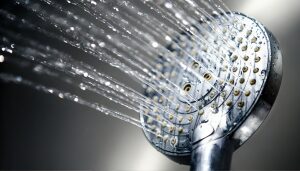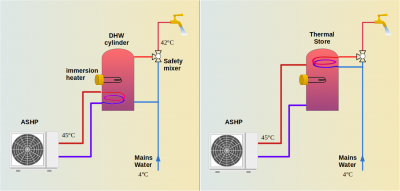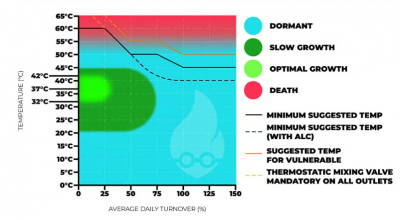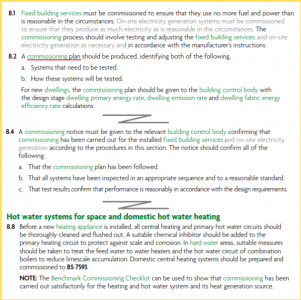Legionnaires' Disease & Home Hot Water: Understanding Risks and Prevention
Recently, we've received numerous questions from homeowners regarding Legionnaires' disease and the necessary precautions to prevent it. It's crucial to understand that the risk and prevention strategies for Legionnaires' disease largely depend on your lifestyle and your hot water usage patterns.
Legionnaires' disease is a potentially severe form of pneumonia caused by inhaling water droplets containing the bacterium Legionella. Despite being relatively rare, it poses significant health risks, particularly to older adults, smokers and individuals with weakened immune systems. In the UK, there is a substantial amount of misunderstanding about Legionnaires' disease and how to prevent it, especially in domestic settings. This article aims to clarify these misconceptions and provide guidance on maintaining safe water systems in homes.
What is Legionnaires' Disease?
Legionnaires' disease is an infection caused by Legionella bacteria, which thrive in water systems. These bacteria can proliferate in various environments, including hot tubs, cooling towers hot water tanks, and large plumbing systems. When people inhale mist or water droplets containing Legionella, they can develop this serious respiratory illness. Symptoms typically include high fever, chills, cough, muscle aches and headaches.
Legionella in UK Homes
While Legionnaires' disease is more commonly associated with large-scale water systems in commercial or public buildings, residential properties are not immune. However, according to the Public Health England (PHE) reports, domestic cases attributed to household water systems are exceedingly rare. The PHE's surveillance data from January to October 2020 (the most recent data we could find) indicates that most reported cases of Legionnaires' disease were linked to community exposure or travel-related incidents, not to home water systems.
Preventing Legionella Growth in Home Water Systems
To prevent Legionella growth, it's crucial to understand the conditions that facilitate its proliferation. Legionella bacteria thrive in stagnant water and at temperatures between 20°C and 45°C. Therefore, preventing water stagnation and maintaining appropriate water temperatures are key preventive measures.
Anti-Legionella Cycles
One recommended method for preventing Legionella growth is the implementation of Anti-Legionella Cycles (ALC). These cycles involve temporarily increasing the temperature of the hot water system to kill any bacteria present. For homeowners storing hot water at lower temperatures (40°C to 49°C), being aware of and occasionally utilising ALC can provide peace of mind.
Here’s a guide on how to implement ALC in your home:
- Temperature Settings: Set your hot water system to at least 60°C periodically. This temperature is sufficient to kill Legionella bacteria effectively. Most advice is from manufacturers and installers is to do this on a weekly basis.
- Running Water: Run all hot water outlets for at least five minutes to ensure the elevated temperature reaches every part of the system.
- Frequency: If your water system undergoes full turnover every day or so, ALC might not be necessary regularly. However, consider performing this cycle after extended periods of inactivity, such as after a holiday or at least once a year.
Heat pump controllers often have built-in sterilisation functions, usually weekly, to maintain safe water temperatures without manual intervention. While 60°C is a commonly recommended temperature, heating the water above 50°C can still kill Legionella bacteria, albeit over a longer period.
Balancing Efficiency and Safety
The goal is to maintain the lowest possible water storage temperature while ensuring safety. For many homes, a storage temperature of 50°C is adequate, striking a balance between energy efficiency and safety. Keeping water at this temperature can improve the efficiency of heat pumps (and boilers) and reduce heat loss from the cylinder.
For families with high water turnover, such as daily usage that fully cycles the stored water, maintaining a storage temperature of around 45°C without regular ALC might suffice. However, higher risk households – those with elderly members or individuals with compromised immune systems – should consider maintaining higher temperatures for added safety.
Understanding Stagnant Water
Stagnant water, where Legionella can grow, is characterised by low turnover rates. In domestic settings, smaller water heaters or instantaneous water heaters generally have high turnover rates and pose minimal risk. In contrast, larger storage systems with sporadic usage can create environments conducive to bacterial growth.
Temperature and Legionella
Legionella growth rates vary with temperature:
- 0°C to 20°C: Dormant
- 20°C to 32°C: Slow growth
- 32°C to 42°C: Optimal growth
- 42°C to 45°C: Slow growth
- 45°C to 50°C: Dormant again
For effective pasteurisation:
- 50°C: 90% die-off in 80-125 minutes
- 55°C: 90% die-off in 20 minutes, 100% in 5-6 hours
- 60°C: 90% die-off in 2 minutes, 100% in 30 minutes
- 65°C: 90% die-off in around 10 seconds, 100% in 2 minutes
- 70°C: Instant death
In most domestic settings, maintaining a hot water temperature of around 50°C is sufficient to prevent Legionella growth. As mentioned earlier, for households with vulnerable individuals, or those seeking extra assurance, implementing periodic Anti-Legionella Cycles by heating water to 60°C can provide added safety and peace of mind. Balancing efficiency and safety is key, and by following these guidelines, homeowners can ensure their water systems are both safe and cost-effective.
For us and our home, because we work from home, we turnover around 100% of our stored water each day. This high turnover allows us to keep our stored water at 45°C without performing regular Anti-Legionella Cycles. This approach has proven effective for our lifestyle, combining energy efficiency with safety.
Get a copy of The Ultimate Guide to Heat Pumps
Subscribe and follow our YouTube channel!
May I throw in two other factors?
1. Biology: The bacteria have to come from somewhere in the first place. Historically the culprit was a header-tank in the loft which supplies the DHW cylinder.
In these days of having DHW at mains pressure, the opportunity for Legionella pneumophila to enter the system is much reduced. Modern likely sources are hot-tubs.
Even so, let's note that the pneumonia which affects humans comes from breathing in water droplets, rather than through drinking the water.
This is perhaps why a Legionella infection catches us by surprise. You could use a shower for years without getting pneumonia even tho' there's Legionella in the water. And then one day you clean out the shower tray without first soaking the cloth in disinfectant and you breath in the bacteria which gets wafted into the air.
Perhaps the worst possible source of Legionella is the water which comes from flushing out an UFH pipe network, or getting close to the air-relief valve at the end of the manifold.
2. Stagnation: Those of us with thermal stores are less likely to provide a breeding ground for Legionella pneumophila.
The coil which picks up the heat energy for DHW has low volume and the water in it is frequently being replaced.
To have sufficient bacteria present for infection to occur requires them to replicate in water being held at 35°C - 45°C for long enough.
That occurs in a DHW cylinder [left side of diagram] where there is a larger volume of water which isn't getting used.
The human body is pretty good at fighting off small numbers of bacteria. We are susceptible to pneumonia only when the natural defenses are overwhelmed.
Save energy... recycle electrons!
Heat Geek have a good article on this. I normally heat the DHW to only 42degC, but we have a high turnover. It gets plenty of extra temperature in these sunnier months as we make use of the abundant energy from the solar PV.
My take from the above is; If the DHW is never stored below 45c the a LHC to 60c is unnecessary?
So, is it cheaper to maintain a temp’ above 45c and ignore a LHC or lower and run a regular LHC? Interesting.
Retrofitted 11.2kw Mitsubishi Ecodan to new radiators commissioned November 2021.
14 x 500w Monocrystalline solar panels.
2 ESS Smile G3 10.1 batteries.
ESS Smile G3 5kw inverter.
Perhaps I should also observe that bacteria can be eradicated by UV-C 'light', but I've not heard of that approach being used against Legionella.
UV radiation of 265nm wavelength is usually produced using a fluorescent tube, but you can now buy LED emitters at that wavelength. I have one of each type in my house, where they're used in the cold water supplies from my well.
UV-C destroys the RNA within the bacterial cell, which stops it reproducing.
DNA in protozoa is also denatured by UV-C, so that reduces any risk of amoebic dysentery too.
I'm only mentioning it here in case someone else comes up with a possible defence against Legionella.
At the moment I can't think how that radiation could be usefully deployed into DHW.
Save energy... recycle electrons!
Posted by: @steve81ukHeat Geek have a good article on this. I normally heat the DHW to only 42degC, but we have a high turnover. It gets plenty of extra temperature in these sunnier months as we make use of the abundant energy from the solar PV.
This is from that article and i found it useful:
“Anything worth doing, is worth doing right.”
@transparent I believe D Trump had a cunning plan to fight a recent pandemic using fluorescent tubes 😀
My take is I run my anti-Legionella cycle on Monday afternoons ending at 5pm, and the temperature probe (at the bottom end of the HW cylinder) says 58.5C; it's still above 55C at 2am on Tuesday, which ought to be ample for killing them all off. After that, I don't see how it would re-enter the system, but for 2 hours a week, it's peace of mind.
Grant Aerona 3 10kW
It is unfortunate that D Trump doesn't take advantage of discussion forums such as this one to allow such notions to be subjected to 'peer review'!
And I regret the awkward position in which he placed Dr Deborah Birx, White House coronavirus advisor, who was sitting close by. The press/media were less likely to follow her advice after that incident in which she was undermined.
Are we not in a similar position regarding the wider issues of energy strategy in this country?
This forum is widely populated with tales of incorrect installation and commissioning of heat-pumps.
Whilst most homeowners will notice inefficiencies and high bills, I doubt that they'd be aware of a failure to implement anti-legionella procedures.
How long will it be before we hear of the first case of pneumonia as a result?
... and what effect will that have on the uptake of heat-pumps to achieve net zero?!
Do you think MCS even has a suitably experienced scientific advisor on its staff to forewarn them of a possible legionella infection?
Save energy... recycle electrons!
I've ditched the weekly 1hr Legionella cycle using the 3kW immersion heater fitted to a Grant 250L pre-plumbed cylinder. I was finding it ineffective due to the location of the immersion and sensitivity of the in-built immersion control thermostat. The tank was never recording a higher temperature than 55degC and the immersion was just cycling on/off. It was creating a small pocket of hot water, but not effectively heating the cylinder contents.
I've proved this by noting how much quicker the DHW ran cool when heated with the 3KW immersion heater compared to the ASHP primary coil. The ASHP provides a much more thorough heating. *
Instead I have a daily ASHP DHW generation to 55degC. The ASHP happily supplies water in the primary side at 60degC to facilitate this. The tank thermostat is set to 55degC. The primary coil sits lower down in the cylinder and has a much greater surface area than the immersion heater element. It does a much better job of heating the cylinder up to 55degC. The DHW charge time using the ASHP is a maximum of 75 minutes scheduled at 1pm each day. The cylinder contents sit at 55degC for several hours in the afternoon, during which time almost no hot water is used, and that's sufficient a Legionella safeguard. I've not noticed any increase in running costs having the DHW set at 55degC than, say, 50degC. The standing losses from well insulated cylinder tanks are very low - the tank loses about a degree of indicated storage temperature every 3 hours or so. Crucially, her who shall be obeyed wants hot water at 50degC for pot washing!
* Most domestic small tanks use stratification intentionally - drawing off hot water from the top and replacing with cold water at the bottom. Gradually, the % of cold water in the tank increases as hot water is drawn off. The boundary layer between hot and cold contents will always sit around the tepid 'Legionella risk' temperature until the cylinder is recharged and reheated. There is no mixing and blending of incoming cold water with hot water, which is much more common with industrial calorifiers and hot water systems. Smaller DHW cylinders have their volumetric content quite quickly replenished based on an average daily consumption of 35-40 litres per occupant.
Posted by: @allyfishThe boundary layer between hot and cold contents will always sit around the tepid 'Legionella risk' temperature [...]
There is no mixing and blending of incoming cold water with hot water...
I had suspected that might be the case.
I've just notified my County Councillor about the risks of legionella with the lower temperatures which occur with heat-pumps.
It took her less than 5-mins to forward my email to Environmental Health (Borough Council) and Public Health (County Council) officers.
I suspect that the wider population with heat-pumps are remaining 'protected' from legionaires disease because the bacteria aren't finding their way into the DHW cylinder in the first place, rather than because installers have ensured that an effective anti-legionella process is operational.
That could be readily verified.
Here's the relevant section of the Building Regs, Approved Documents Part-L:
A householder merely needs to look at the Commissioning Plan for their house...
... run their finger down the list until they arrive at the section on Anti-Legionella
... read what the system test-sequence involved
... and check that it's been ticked as 'completed'.
What's the chances of that having occurred? 🤔
Save energy... recycle electrons!
Two further points:
1: Legionella is a Notifiable Disease to UK Health Security Agency. Any infection is subject to an investigation which must identify the source.
I've posed the question as to why a potential risk isn't notifiable.
Prevention would seem to be the better option!
2: The DESNZ Public Consultation on Delivering a smart and secure electricity system (closing date is tomorrow 21st June) contains a number of questions in Section-1 on their proposals to include Heat-Pumps within the corpus of devices subject to DSR controls (Demand Side Response).
In short that means they intend to legislate to allow Service Providers to switch off your heat-pump during times of high grid demand. This would work in similar fashion to smart EV chargers being controlled by your electricity supplier.
That comes with the risk that your heat-pump might've been switched off during a period when the anti-legionella cycle would normally have run. It also means that the DHW tank temperature is more likely to have dropped to a temperature where growth of legionella bacteria would be increased.
If that were so, how would a homeowner know that the anti-legionella cycle hadn't occurred?
Is it reported somewhere?
Can a heat-pump be requested to report the last time the cycle had run?
Given the dearth of site-specific information and instruction given to homeowners, how many are likely to know how to start an anti-legionella cycle manually, even if they realised that it hadn't occurred to a programmed schedule?
Save energy... recycle electrons!
- 26 Forums
- 2,426 Topics
- 55.1 K Posts
- 140 Online
- 6,104 Members
Join Us!
Worth Watching
Latest Posts
-
RE: Is it normal to use power from the grid when running off the battery?
@batpred I may be asking you for more info in how you h...
By JohnnyB , 3 hours ago
-
RE: Recommended home battery inverters + regulatory matters - help requested
@johnnyb The noise of the Solis is nothing very sign...
By Batpred , 3 hours ago
-
RE: Is my Samsung gen6 outside air temp sensor missing a sheath/sleeve?
@papahuhu Yes, good information is often hard to find, ...
By Old_Scientist , 3 hours ago
-
RE: R290 and Foundation Air Bricks
Professional risk assessment (inc some common sense) ...
By ASHP-BOBBA , 3 hours ago
-

RE: The good, the bad and the not that great – my heat pump installation
@toodles ahhh no trouble yeah probably won't mess with ...
By Burtis , 4 hours ago
-
RE: Daikin Wireless Thermostat
@bash we have mostly south facing rooms which would ove...
By Judith , 5 hours ago
-

RE: Post-Traumatic Heat Pump Stress Disorder
Some more examples of those that really should be benef...
By Jeff , 6 hours ago
-
RE: Installer Fitted 9kW Instead of 11kW Heat Pump and Changed MCS Paperwork - What do I do?
I've now had an interesting email from a Complaints Res...
By MairiA , 8 hours ago
-

RE: Reliable, easy to use home battery options
Correct. LiFePO₄ cells mustn't be charged if their te...
By Transparent , 8 hours ago
-

RE: Water outage in the the south-east
Indeed!Any contamination in the well water would be tra...
By Transparent , 10 hours ago
-
RE: Solis inverters S6-EH1P: pros and cons and battery options
I hear some cases of apparent misconfiguration of inver...
By Batpred , 10 hours ago
-
Are split ASHPs with R290 refrigerant coming soon?
Question. Are there any (or likely to be in the near t...
By iotum , 12 hours ago
-

RE: Setback savings - fact or fiction?
Indeed. In many ways, a defrost is a setback, with the ...
By cathodeRay , 12 hours ago
-
RE: Heat pump not reaching flow temperature
The good news is that it leaves no excuse if it doesn't...
By JamesPa , 13 hours ago
-
RE: How to use my Hanchu battery storage for home without it feeding back into the grid?
@countryman-helmsley In that case is there a button ...
By IRMartini , 13 hours ago
-
RE: Ideal HP290 14kW ASHP - how to optimise
Great. It’s not bad is it, though I agree it may repres...
By Davesoa , 15 hours ago
-
RE: Ecodan Pump Issues… Circulation pump turns off when heat pump compressor turns off
@f1p apologies, you are absolutely correct
By Patch321 , 15 hours ago
-

RE: Samsung E101 Error Message and my ASHP Efficiency
@johnnyb amazing that the our forum is serving its purp...
By Mars , 1 day ago
-
Best option for controller upgrade? - Grant Aerona
Fairly new heat pump owner - Grant Aerona 3 10kw - and ...
By Topher , 1 day ago
-

Just a brief update to keep things transparent. Secti...
By DREI , 1 day ago












